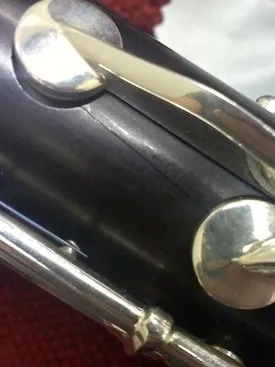Monday, February 13, 2023

Break-In
If you conduct a google search for breaking in a clarinet, you will discover a lot of conflicting information. Some say to just play the instrument as usual without any breaking in process while others suggest that the breaking in process should last about a year. If you take a moment to think about it rationally, an excess amount of playing on a new instrument is less than ideal. The wood on the inside of the instrument must be introduced to warmth and moisture in stages in order to prevent overwhelming the wood. Based on my opinion and experience, the following schedule should be sufficient during any season except for winter:
Day 1-3: play for 10 minutes, swab out thoroughly and return to case
Day 4-6: play for 15 minutes, swab out thoroughly and return to case
Day 7-9: play for two sessions of 15 minutes each (split up; morning/evening), swab out thoroughly and return to case
Day 11-13: play for two sessions of 20 minutes each (split up; morning/evening), swab out thoroughly and return to case
Day 14 and forward: increase play time by five minutes each day until you are playing the instrument normally
If you take more than one day off away from the instrument, avoid overwhelming the wood by breaking up your practice a bit until you are playing the instrument normally again. If you are breaking in a clarinet during the winter, add much more time to each stage listed above (at least double and more as an extra precaution). If possible, avoid breaking in a clarinet during the winter!
Basic Care
Taking care of a wooden clarinet is more involved than a clarinet made plastic or a composite material. The tips below are fairly standard:
- If you live in a dry or low humidity climate, keep one or two fresh orange peels in the case at all times (change out two to three times per week). If you live in a high humidity climate, use orange peels during the winter months. Make sure the peels are small like in the picture and avoid allowing the peels to come into contact with your clarinet.
- Avoid putting a clarinet near a door, window or heating/cooling vent and never leave it in a hot or cold place (car, garage, etc.).
- Be sure to warm up the outside of the instrument before playing by holding with the hands or placing the joints under your arms (this is more important for the upper joint as most cracks tend to occur in the upper joint).
- Every time you are finished practicing or playing, swab out thoroughly and return the instrument to the case making sure to wipe out any excess water that may have settled where the joints connect. Silk swabs tend to absorb the moisture the best.
- Make it a habit to regularly examine the upper joint under a good light source to look for cracks. If you catch a crack early, it can be fixed before it goes all the way through. If you think you see a crack, stop playing immediately. Further playing will make the crack grow. Can you see the crack in the picture?
- Examine the rings on the bell and barrel regularly. If anything feels loose, stop playing immediately. These need to be tightened before playing again to prevent cracking.
- You may hear people talking about oiling the wood of the instrument. DO NOT attempt to do this yourself. Generally, in my opinion, if you keep the orange peels going consistently in the case, oiling the wood is unnecessary. Consult with your professional instrument repairman to have them assess whether the instrument needs to be oiled (based on where you live and whether you consistently keep orange peels in your case, etc.


| Dr. Kristen Denney Chambers is a clarinetist, teacher, and composer, has performed as a freelance, chamber, and orchestral clarinetist in several venues including the Ameropa Chamber Music Festival in Prague, the Fort Smith Symphony, Wyoming Symphony, Longmont Symphony, Colorado Light Opera, and the Tulsa Symphony. Her method book "Finger Fitness Book 2" has been selected as an OMEA new method book for low clarinets. |
| (417) 882-7000 | (573) 256-5555 | (816) 792-8301 |
| (417) 781-3100 | (405) 896-8111 | (479) 464-8877 |
| (918) 286-1555 | (636) 229-1904 | (417) 882-7000 |
